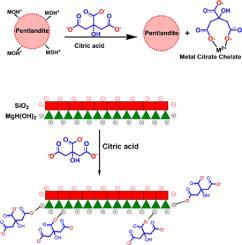Resources, Conservation and Recycling ( IF 13.2 ) Pub Date : 2022-07-17 , DOI: 10.1016/j.resconrec.2022.106496 Omar Bashir Wani , Sama Manzoor , Nahid Molaei , Mohammad Shoaib , Shaihroz Khan , Hongbo Zeng , Erin R Bobicki

|
The processing of ultramafic ores requires fine grinding, which can result in slime-coating of the nickel-bearing mineral, pentlandite, by the phyllosilicate gangue mineral, serpentine. This lowers nickel recovery and concentrate grade during froth flotation operations. The presence of divalent cations in process water exacerbates the detrimental effects of phyllosilicates on nickel recovery by enhancing the positive surface charge of serpentine and causing charge reversal of pentlandite. To mitigate these issues, an environmentally benign, nontoxic, and biodegradable reagent, sodium citrate, was used in this study to chelate divalent cations on the pentlandite surface and desorb them from the mineral surface. The metal-citrate complexes adsorb onto the positively charged serpentine surface, reversing its charge. Sodium citrate was able to restore the surface charge and hydrophobicity of pentlandite, reverse the charge of serpentine, desorb the divalent cations from the mineral surface, and prevent MgO gangue recovery to the froth phase. Microflotation studies demonstrated that upon the addition of sodium citrate, nickel recovery increased from 74 to 96% and nickel grade was improved from 11 to 15.1% . The hydrophobicity of pentlandite was restored upon conditioning with citrate as evident by increase in water static contact angle from 50° to 70° , DLVO interactions showed that addition of citrate prevents slime coating of pentlandite by serpentine. The results demonstrated the depressive and dispersive action of sodium citrate.
中文翻译:

从超镁铁矿中提炼镍:使用柠檬酸钠作为绿色加工试剂
超镁铁矿的加工需要精细研磨,这会导致页硅酸盐脉石矿物蛇纹石对含镍矿物镍铬铁矿进行粘泥涂层。这会降低泡沫浮选操作期间的镍回收率和精矿品位。工艺用水中二价阳离子的存在通过增强蛇纹石的正表面电荷和导致镍钴矿的电荷反转,加剧了页硅酸盐对镍回收的不利影响。为了缓解这些问题,本研究中使用了一种环境友好、无毒且可生物降解的试剂柠檬酸钠,以螯合镍铬铁矿表面的二价阳离子并将它们从矿物表面解吸。金属-柠檬酸盐络合物吸附在带正电的蛇形石表面上,反转其电荷。柠檬酸钠能够恢复镍铬铁矿的表面电荷和疏水性,逆转蛇纹石的电荷,从矿物表面解吸二价阳离子,并防止 MgO 脉石恢复到泡沫相。微浮选研究表明,添加柠檬酸钠后,镍回收率从 74% 提高到 96%,镍品位从 11% 提高到 15.1%。用柠檬酸盐调理后,镍钴矿的疏水性得到恢复,这可以通过将水静态接触角从 50° 增加到 70° 来证明,DLVO 相互作用表明,柠檬酸盐的添加防止了蛇纹石对镍钴矿的粘液涂层。结果证明了柠檬酸钠的抑制和分散作用。从矿物表面解吸二价阳离子,防止 MgO 脉石恢复到泡沫相。微浮选研究表明,添加柠檬酸钠后,镍回收率从 74% 提高到 96%,镍品位从 11% 提高到 15.1%。用柠檬酸盐调理后,镍钴矿的疏水性得到恢复,这可以通过将水静态接触角从 50° 增加到 70° 来证明,DLVO 相互作用表明,柠檬酸盐的添加防止了蛇纹石对镍钴矿的粘液涂层。结果证明了柠檬酸钠的抑制和分散作用。从矿物表面解吸二价阳离子,防止 MgO 脉石恢复到泡沫相。微浮选研究表明,添加柠檬酸钠后,镍回收率从 74% 提高到 96%,镍品位从 11% 提高到 15.1%。用柠檬酸盐调理后,镍钴矿的疏水性得到恢复,这可以通过将水静态接触角从 50° 增加到 70° 来证明,DLVO 相互作用表明,柠檬酸盐的添加防止了蛇纹石对镍钴矿的粘液涂层。结果证明了柠檬酸钠的抑制和分散作用。用柠檬酸盐调理后,镍钴矿的疏水性得到恢复,这可以通过将水静态接触角从 50° 增加到 70° 来证明,DLVO 相互作用表明,柠檬酸盐的添加防止了蛇纹石对镍钴矿的粘液涂层。结果证明了柠檬酸钠的抑制和分散作用。用柠檬酸盐调理后,镍钴矿的疏水性得到恢复,这可以通过将水静态接触角从 50° 增加到 70° 来证明,DLVO 相互作用表明,柠檬酸盐的添加防止了蛇纹石对镍钴矿的粘液涂层。结果证明了柠檬酸钠的抑制和分散作用。



























 京公网安备 11010802027423号
京公网安备 11010802027423号